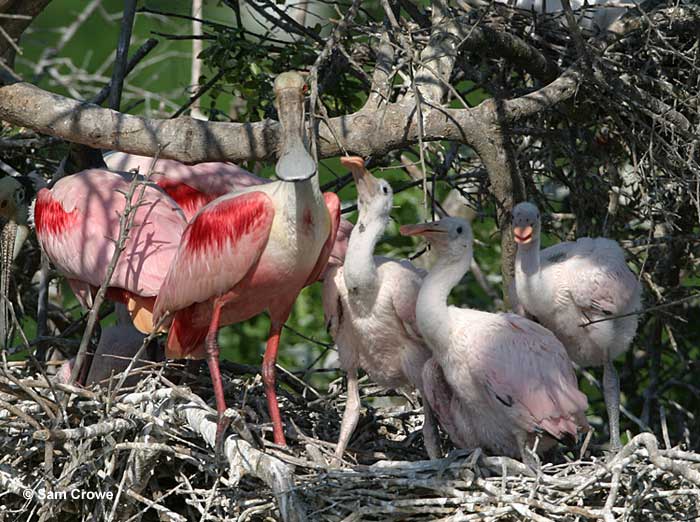The striking and beautiful Roseate Spoonbill (Platalea ajaja) is a bird that captures the attention of anyone who has the luck to meet them.
These pink-feathered birds with elongated bills are found in wetlands, marshes, and swamps across the Americas, from the southern United States to Argentina.
Roseate Spoonbills are fascinating creatures with unique habits and physical adaptations, so don’t hesitate to read more about them!
On this page
Identification
The Roseate Spoonbill is a medium-sized wading bird that measures 28-34 inches long, has a wingspan of 47-52 inches, and weighs between 2.6-4 pounds. The bird got its name from its distinctive spoon-like bill. In addition to that, you can identify the bird by its long elongated legs, neck, and bill.
The male and female Roseate Spoonbill don’t have differences in their plumage. Both of them have a white neck and upper back, light pink underparts and wings, and striking wine-red shoulders and tail coverts. They have a bare yellowish head, red eyes, and red legs.
Juvenile Roseate Spoonbills appear similar to adults but are paler in color and have feathers on their heads.
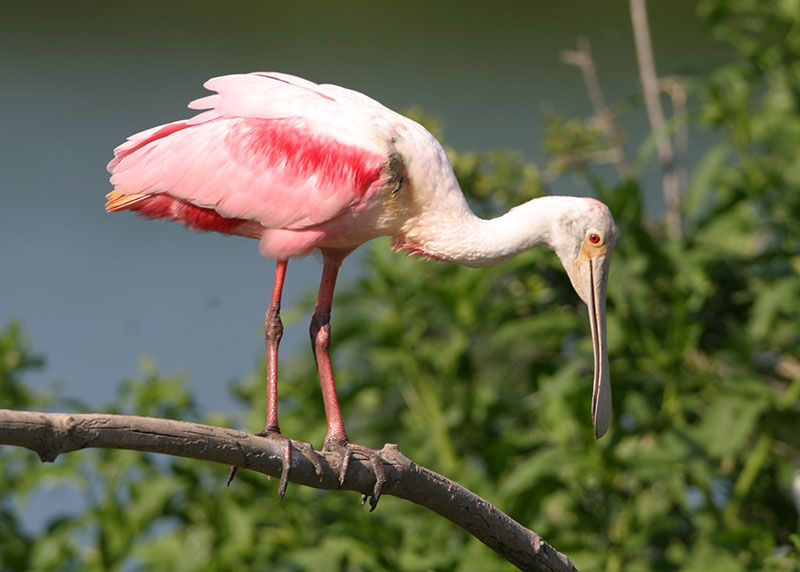
Roseate Spoonbill
Roseate Spoonbills fly with stiff and shallow wingbeats that they alternate with glides. Unlike herons, their neck is outstretched, as are their legs. When resting, they keep their necks in an S-shape.
These birds are relatively quiet and limit their vocalizations to breeding grounds. Roseate Spoonbill calls with low guttural sounds while interacting with their mate, feeding their young, or when they are startled. They may also produce a low rattling sound.
Food
Roseate Spoonbill’s diet mostly consists of aquatic invertebrates. They forage in shallow water less than 5 inches deep of both fresh- and saltwater habitats, including bays, mangroves, forested swamps, and even ditches.
Their foraging method is rather unique. Roseate Spoonbills wade in shallow, often muddy water. They keep their spoon-shaped bill partly opened and then swish it from side to side through the water, feeling for prey. Once they’ve detected it and think they have it in their bill, they snap the bill closed and swallow the prey whole. Sometimes it might pick up something by sight.
The main part of their diet is made up of small fish, such as minnows and killifish, crustaceans, such as shrimp and prawns, aquatic insects, such as different beetles, mollusks, frogs, newts, and slugs.
They also consume bits of aquatic plant material, such as roots and stems of different sedges.
While foraging, they let out a low guttural sound.
Nesting and Eggs
Roseate Spoonbills build their nests in colonies along with other waterbirds like egrets, ibises, and herons. They prefer to nest on islands or over standing water, in mangroves, Brazilian pepperbush, willows, sea myrtle, or other shrubs near the water.
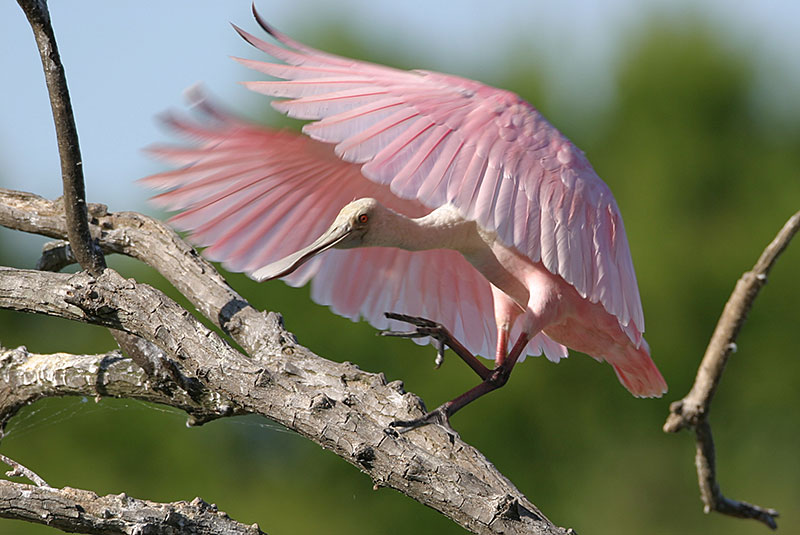
Roseate Spoonbill
The nests are usually located up to 16 feet high in the shadiest part of the tree or shrub. The male Roseate Spoonbill gathers sticks for the females to build a bulky platform, which is lined with finer plant materials such as moss and strips of bark. The nest measures roughly 22 inches wide and 4.5 inches deep.
Roseate Spoonbill eggs are whitish to pale green with brown spots, and they typically lay 2-3 eggs, but sometimes up to 5. The eggs are about 2.2-2.8 inches long and 1.6-1.9 inches wide. Both parents take turns incubating the eggs for about 22-24 days.
Once the chicks hatch, both parents feed them. The young clamber around near the nest and can leave it after 5-6 weeks. They are capable of flight at around 7-8 weeks.
Current Situation
Roseate Spoonbill’s range covers a big part of South America and extends into Central and southern North America. In South America, it occurs mostly east of the Andes, and in Central America and the United States, you can mostly find these birds in coastal regions. In the United States, they’re especially common in Texas, southwest Louisiana, and Florida.
Some Roseate Spoonbills migrate short distances from coastal Texas south to Mexico in the winter or from Florida to Cuba. Overall, however, they are year-round residents. Their migration may also be affected by changes in food availability and water levels.
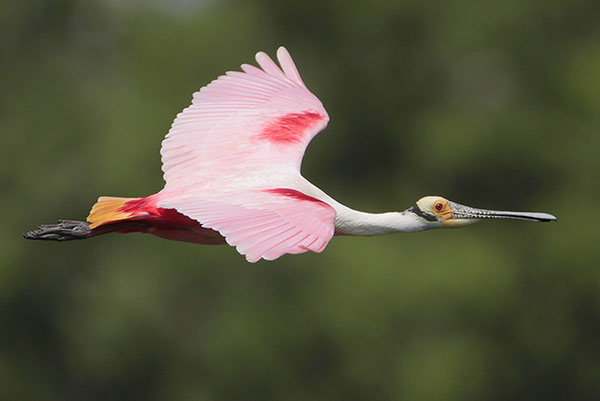
These birds usually inhabit different wetlands and marsh-like habitats, such as mudflats, lagoons, coastal marshes, mangrove swamps, and bays. They prefer to forage in the shallows and nest in trees and bushes near the water.
Roseate Spoonbill’s population is stable, and the species is listed as of least concern in the IUCN Red List. The biggest threat to their survival is the destruction of their natural shallow water habitats.
Luckily, much of their nesting habitats are in protected areas but their foraging range can still be affected by changes in water management which in turn affects their food availability.
Facts
- In the 18th and 19th centuries, Roseate Spoonbills were almost hunted to extinction due to their striking plumage. Their feathers can vary from pale pink to deep wine-red. They get these pigments (specifically carotenoids) from the food they eat.
- Roseate Spoonbills usually live to be around 10 years old in the wild. The oldest known specimen, however, made it to 18 years.
- Roseate Spoonbills are the only spoonbill species found in the Americas.
- Although their spoon-like bill is one of their most distinctive features, these birds are actually not born with it! The bill starts to flatten at 9 days of age and reaches its full size at around the 39-day mark.
- Roseate Spoonbills lose the feathers on their head as they get older.
Similar Species
Roseate Spoonbills have quite a unique appearance which is why there is only one other bird you might confuse it with – the American Flamingo.
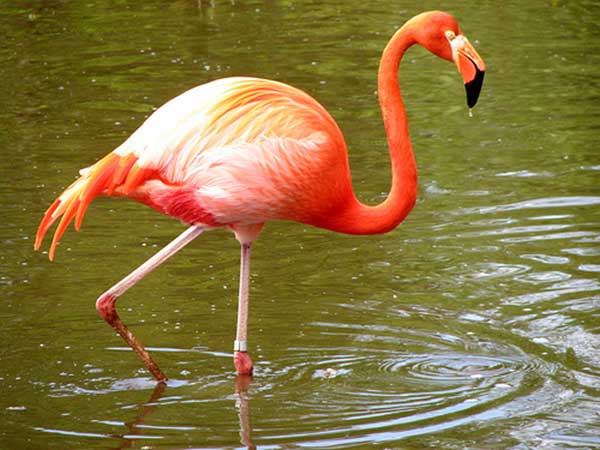
American Flamingo
American Flamingo
Compared to Roseate Spoonbills, American Flamingos are bigger, taller, and have a longer neck that they keep in an S-shape. They’re usually more vibrant in color and lack the long spoon-like bill the Roseate Spoonbill has.
In flight, they can be separated by their flight feathers and neck. American Flamingos have black flight feathers and significantly longer necks and legs.
Frequently Asked Questions
Why is it called a spoonbill?
Spoonbills get their name from their long distinct spoon-shaped bills.
How rare are pink spoonbills?
Pink spoonbills, specifically Roseate Spoonbills, have a large range in South America. However, in the United States, they’re quite uncommon.
What is special about spoonbills?
As the name suggests, spoonbills have a unique flat bill that is similar to a spoon. They keep it partly open and swish it through the water to catch prey.
How many Roseate Rpoonbills are left?
There are about 120,000 mature Roseate Spoonbills left.
What does it mean when you see a Roseate Spoonbill?
When you see a Roseate Spoonbill, it means that there may be obstacles that keep you from reaching your goals. This encounter might indicate that you should take responsibility for your life and be courageous in overcoming your problems.

